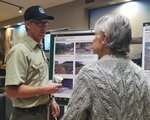

CHELAN – Holden Mine Remedial Project Manager Mario A. Isaias-Vera reported back to Chelan area residents on the project’s five-year review during an open house on Nov. 8 at the Lake Chelan Chamber of Commerce.
The open house served as way to share new information about what has been happening at Holden Village, as well as a way to answer questions from the residents.
The underground copper mine operated from 1937 to 1957 and after it was abandoned, contaminated groundwater and surface water with toxic metals were washed downstream along Railroad Creek.
“There was a need to clean that up,” said Chelan District Ranger Kari Grover-Wier. In 2012, the Forest Service along with the United Stated Environmental Protection Agency issued an order for the site’s cleanup.
The hazardous substances affected wildlife, water and everything else surrounding the Holden Mine. The Forest Service is highly invested in this project because they are thinking long-term. “We are doing it for you, for your children and for generations to come,” said Isaias-Vera.
They are also doing this in order to protect the environment and the natural resources of the area. In order to do so, Remedial Action Objectives were set.
• Protection of aquatic life
• Mitigation of sediments
• Protection of groundwater
• Prevent migration of contaminants of concern that exceed cleanup levels
•Protection of human health
• Compliance with applicable or relevant and appropriate requirements
Holden Mine was divided into sections in order for the project managers to help explain and describe the project with one another.
Not only did Rio Tinto hire locals for the work that needed to be done in Holden Mine, they also hired many from all over the nation.
On a regular basis, the team has to communicate with Holden Village, that way the project doesn’t interfere with their lifestyle.
A key component of the project, included the creation of intersecting channels that helped separate clean water. “It diverted it away from the tailings,” explained Isaias-Vera.
A barrier wall was the hardest part to build, “it protects Railroad Creek from the water that is contaminated and in the contaminated side we developed a collection system.”
The collection system collects the contaminated water and it sends it to “a new developed water treatment plant.” The water treatment plant was designed to treat 2,200 gallons of water per minute.
In 2015, the Wolverine Fire was huge setback for the project, everyone on the site had to be evacuated. However, in 2017 after the site was regraded, 80,000 plants were planted, with all native vegetation. “The site is recovering very rapidly, it’s pretty neat,” said Isaias-Vera.
A network of trails was developed in order to bring recreational opportunities to the area, “not just for the Village but for everyone who wants to visit the site, it’s in a beautiful location.”
The site will continue to be monitored for many years, “we are working with Rio and many agencies on doing monitoring, so far we are happy to see improvements,” informed Isaias- Vera.
Phase 1 of the project will wrap up at the end of the year and a construction break will start. “Rio Tinto has been putting a lot of effort, they have been doing a wonderful job,” he added. The team is scheduled to come back for additional work in a few years from now.
For more detailed information on the Holden Mine Remediation 5 Year Review Report visit the website www.fs.usda.gov/goto/holdenmine.
Comments
No comments on this item Please log in to comment by clicking here